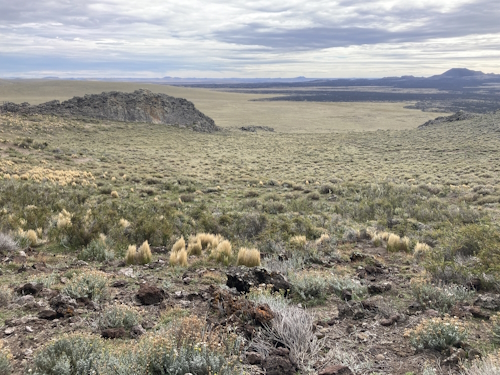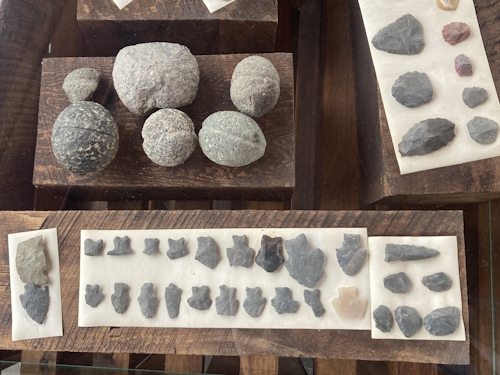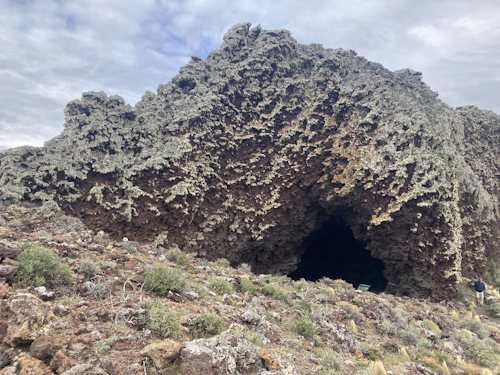Blog TWHS Visits
Fell and Pali Aike Caves
As (T)WHS Travellers, we are blessed that we ‘have to’ visit several sites spread across the Argentinian and Chilean parts of Patagonia. In 11 days, I travelled the area from North to South, covering Los Alerces, Cueva de las Manos, Los Glaciares, and Torres del Paine. Along the way, the landscape changes from forests to glaciers to barren steppe. I finally ended up at Pali Aike NP, the southernmost of the Patagonian (T)WHS. Here windy and cold weather is said to be the norm, but I was lucky to get there on a slightly sunny day, with 11 degrees Celsius and no strong winds.
Pali Aike NP protects the Fell and Pali Aike Caves (the name of the TWHS), and a much larger volcanic landscape. The park lies some 190km from Punta Arenas right at the border with Argentina. I rented a car for the day, as I thought that it would be hard to find a tour going there (seeing the penguin colonies is a much more popular day tour choice). The drive there is easy, just the straight quiet roads that are common in Patagonia. And to top it off, of course, 28km of gravel road to get to the park entrance. This was easily doable in my small rental car. Along the way, there are mostly sheep farms. I had a funny encounter just before arriving at the park gate: a herdsman on horseback was driving all his sheep onward, crossing the road. They ran in multiple single files. I waited for a while to let them pass, as I did not want to hit one and they did not seem to be able to stop. The ranger at the park later told me that this guy manages 8,000 sheep.
The Fell and Pali Aike Caves tentative site is a cultural proposal, focusing on Paleoindian history. What are now known as the earliest hunter-gatherers that have ever lived in this region have left traces such as tools, cremated skeletons and bones of hunted animals. The latter include species now extinct, or that became extinct in the Americas such as the horse before being reintroduced. The age of the findings goes back to almost 11,000 years ago and this is another site that is considered by some as undermining the Clovis First theory. Although the site roughly dates from the same era as Clovis, it challenges the theory anyway because human migration from New Mexico to Southern Patagonia could not have occurred so fast and findings such as the fishtail arrow points show independent development.
Pali Aike National Park is well-organized from a visitor's perspective. At the entrance, you pay your fee (5,500 pesos / 5 EUR) and you get an explanation from the ranger and a brochure about what you can do and see in the park. There are a few exhibits of findings as well. To the general visitor, the volcanic features may be the most interesting, and most trails focus on those as well. Be aware that you still need to drive deeper into the park after the entrance gate, about 20km in total (this is especially important as you have to keep an eye on your fuel levels, as gas stations are few and far between). I started with a look at the salty Laguna Ana, where I met some guanacos who weren’t too skittish.
The best area however is the one you reach turning right after the gate. Here the steppe starts to mix with dark volcanic rocks. You can walk into a crater, but I went straight for the Pali Aike Cave. This is also part of a collapsed crater and the rocks are fully overgrown with lichen and moss; they look very weird (see Photo 3). A half-hour trail awaits with some information panels about the life of the Aonikenk, the indigenous population of Patagonia. The Cave itself is what you would expect from any old cave where important archeological findings have been made – there’s nothing special to see!
From what I was able to find online, the other of the two caves (Fell Cave) can only be visited with special authorization. It is not displayed on the park map and seems to lie on private land. Still, Pali Aike NP is a fine place to visit also for its natural features.
Els - 10 March 2024
Comments
Mel 13 October 2024
Stumbled upon your blog and thanks for the write up! Don't see much on Pali Aike.
Can you comment more on the roads? You felt comfortable in a small car? I'm nervous about driving on dirt roads when it's so remote...
Els Slots 10 March 2024
Fortunately for you, Liam, the Worker Assembly Halls will be a serial transnational nomination with plenty of locations in Europe. So no problem missing the one in Buenos Aires.
Pali Aike of course is more grave: it's a unique representation of the region.
Liam 10 March 2024
I think I've passed by here by less than 40km. So, selfishly, I hope it doesn't get inscribed!
I'm still reeling from this week's reviews of the CGT headquarters in Buenos Aires revealing that I probably walked right past it (or, at most, one block away) in 2012.


